Yearender: Bringing multi-dimensional connectivity, Belt and Road means a lot to many Asian countries
 0 Comment(s)
0 Comment(s) Print
Print E-mail Xinhua, 12 29, 2020
E-mail Xinhua, 12 29, 2020
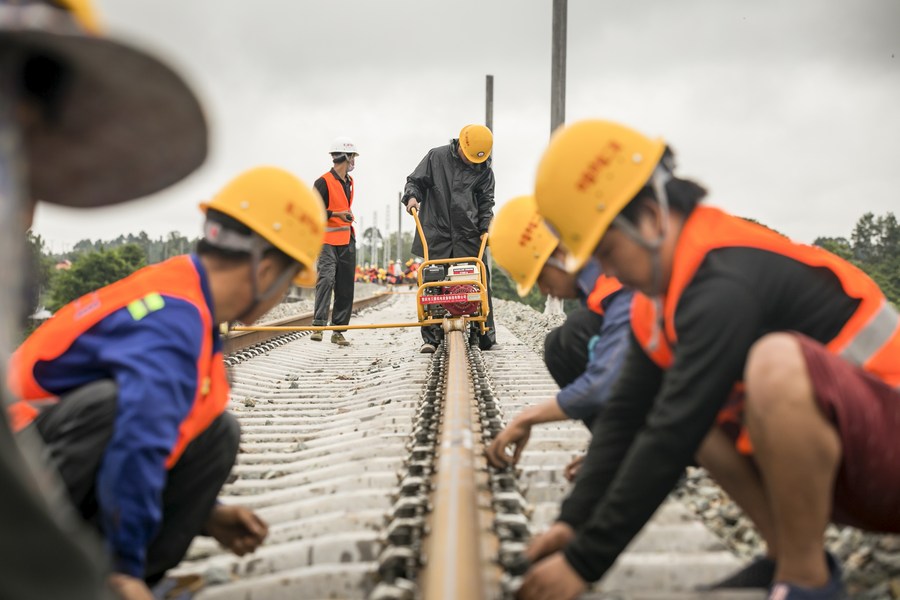
Workers install seamless welded rails on the China-Laos railway in the northern suburbs of Vientiane, Laos, June 18, 2020. (Photo by Kaikeo Saiyasane/Xinhua)
By building the first expressway, metro line or the biggest bridge in some Asian countries, the Belt and Road helps boost economic growth and realize people's dream of a better life.
by Qu Junya, Yao Lan, Zhao Qing
HONG KONG, Dec. 29 (Xinhua) -- By bringing multi-dimensional connectivity, the Belt and Road Initiative (BRI) means a lot to Asian countries like Bangladesh, Cambodia, Indonesia, Laos, Pakistan and Sri Lanka.
What is Belt &Road?
Proposed by China in 2013, the BRI, which consists of the Silk Road Economic Belt and the 21st-Century Maritime Silk Road, features building infrastructure and trade networks to connect Asia, Europe and Africa along the ancient trade routes of the Silk Road.
PURSUING DREAMS
The Belt and Road is not only about national development and regional integration, but is also about the dreams of ordinary people.
Known as Song Peng, the 23-year-old trainee for the China-Laos Railway under construction wants to become the first female train driver on the first modernized railway in Laos. "I think women can also do things men can do."
For 23-year-old Najeeb Uddin, meanwhile, a handicraft shop owner in northern Pakistan's Hunza Valley, the Karakoram Highway (KKH), also known as the China-Pakistan Friendship Highway, has brought him more income.
"My business is getting better and better in recent years," Uddin told Xinhua. "None of this can be achieved without the Karakoram Highway outside the door ... A good road is a precondition for attracting tourists."
"The road is the most important means of earning bread and butter for the people of the area."
The Karakoram Highway, one of the world's highest paved roads and a popular tourist attraction, is often referred to as the Eighth Wonder of the World due in part to the difficult conditions in which it was constructed.
"The road is the most important means of earning bread and butter for the people of the area," Faizullah Firak, Gilgit-Baltistan government spokesperson, said.
Now the highway reaches further in its extension as part of the Belt and Road.

A view of the old city of Hunza valley in Pakistan's northern Gilgit-Baltistan region, where the Karakoram Highway runs through, Oct.17, 2020. (Xinhua/Liu Tian)
FAST ROAD, FAST TRACK
The China-Laos Railway and a high-speed railway in Indonesia are among the Belt and Road projects for faster transport, trade and growth.
The 414-km Laos-China Railway, a strategic docking project between the BRI and Laos' development strategy to turn the land-locked country into a land-linked hub, is a "long-awaited road of dreams" for the people, said Saithong Keoduangdy, chairman of the Lao National Assembly Law Committee.
"Its opening to traffic next year will improve the living standards of the people along the railway, will increase employment, and help the Lao people walk on their way to prosperity," he said.
"The Laos-China Railway is a long-awaited road of dreams for the people of Laos."
The 142.3-km Jakarta-Bandung High-Speed Railway, launched in 2016 with a design speed of 350 km per hour, is expected to cut the traveling time from Indonesia's largest city Jakarta to West Java province's capital Bandung to 40 minutes from more than three hours.
Indonesian President Joko Widodo said, "The increasing mobility of people and products will lead us to win the competition among nations."

The closure of the 64-m continuous girders for a Jakarta-Bandung High-Speed Railway bridge in Indonesia, Sept. 26, 2020 (Photo by Liu Meiling/Xinhua)
FIRSTS, BIGGEST
The Belt and Road means "firsts," among which are the first metro line in Pakistan and the first expressway in Laos, and it means the biggest bridge for Bangladesh.
Pakistan's 27-km Lahore metro Orange Line, with a daily ridership capacity of 250,000 people, runs through Lahore's heavily populated areas and provides a splendid overlook of the Shalamar Gardens, a UNESCO-listed world cultural heritage.
"The people in Pakistan, up until now, have never experienced such a good project especially regarding transportation for the general public," passenger Rehan Fazal, an electrical engineer, said.
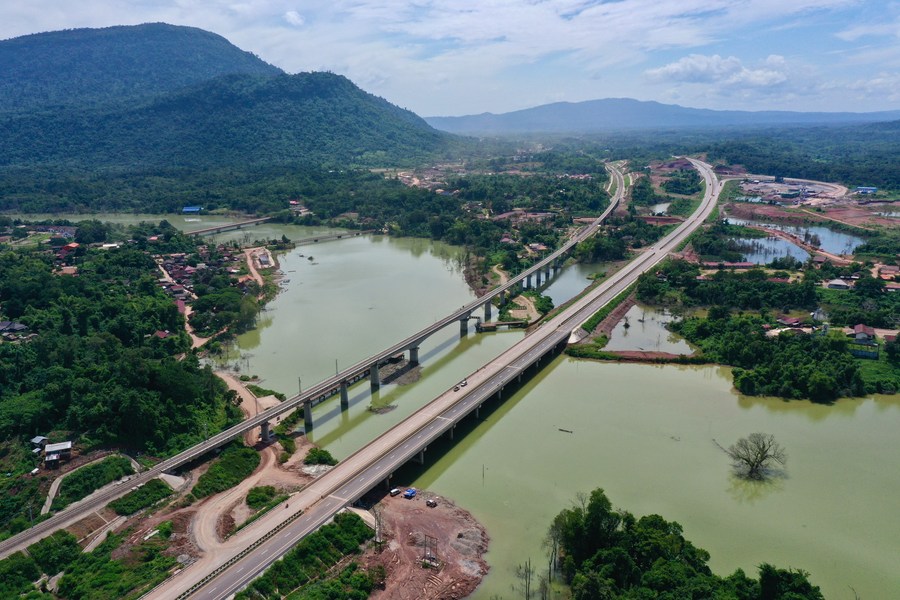
A view of the initial Vientiane-Vang Vieng section of the China-Laos expressway (R), next to a China-Laos Railway bridge in Vientiane Province, Laos, Oct. 21, 2020. (Yunnan Construction and Investment Holding Group/Handout via Xinhua)
The 440-km China-Laos expressway will connect the Lao capital Vientiane with the northern town Boten bordering China. With a design speed of 80-100 km per hour, the highway built from the end of 2018 will shorten the trip from Vientiane to the tourist-oriented town of Vang Vieng to one hour from 3.5 hours.
"This is our first expressway in Laos, and we hope that other places in Laos can have such good roads like this in the future," Khonsavan Silasong, a 22-year-old Vientiane resident, said.
The multi-purpose Padma Bridge, the biggest of its kind in Bangladesh, which is designed to connect the country's northwest and southwest, is expected to be completed by the end of 2021.
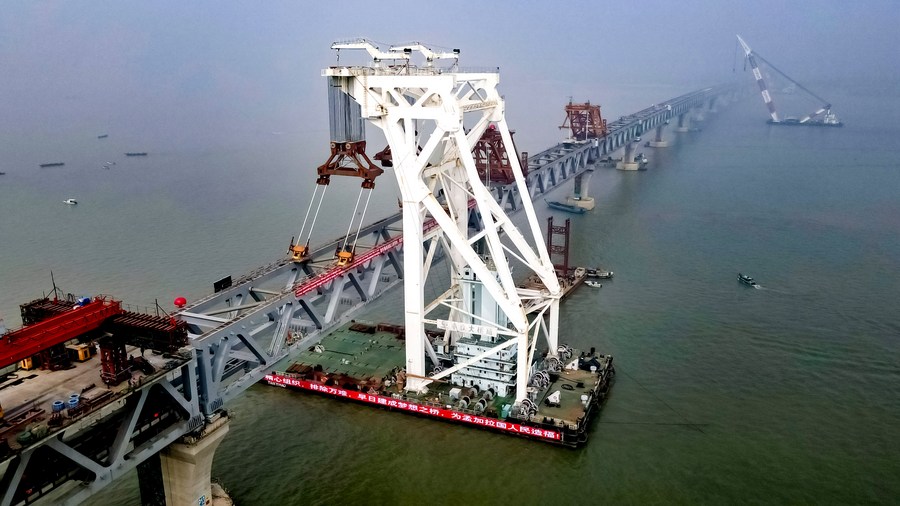
The last span of the Padma Bridge is installed above the Padma river at Munshiganj, some 40 km southwest of Dhaka, capital of Bangladesh, Dec. 10, 2020. (Xinhua)
"Experts said the double-deck Padma Bridge, with road and rail tracks, is expected to contribute around 1.3 to 2 percent to the annual GDP growth, reduce poverty and increase economic activities of the people of the neglected southwestern region," the Dhaka Tribune reported.
The latest timeline of Belt &Road in Southeast Asia this year:
July 28 -- KKH-extension motorway was fully opened to traffic;
Oct. 25 -- Lahore metro Orange Line launched commercial service;
Nov. 15 -- 3rd tunnel on Jakarta-Bandung High-Speed Railway was bored through;
Dec. 10 -- Padma Bridge's last span was installed;
Dec. 20 -- Vientiane-Vang Vieng expressway was opened to traffic.
CLEAN WATER, CLEAN POWER
The Belt and Road means clean water for tens of thousands of residents in rural Cambodia and elsewhere, and clean electricity power for better lives as well as smoother production activities in Cambodia, Laos, Myanmar, Nepal and Pakistan, among others.
Launched in November 2019, the two-year China-Aid Cambodia Rural Water Supply Project Phase II will dig 964 boreholes and 54 community ponds in 10 provinces.
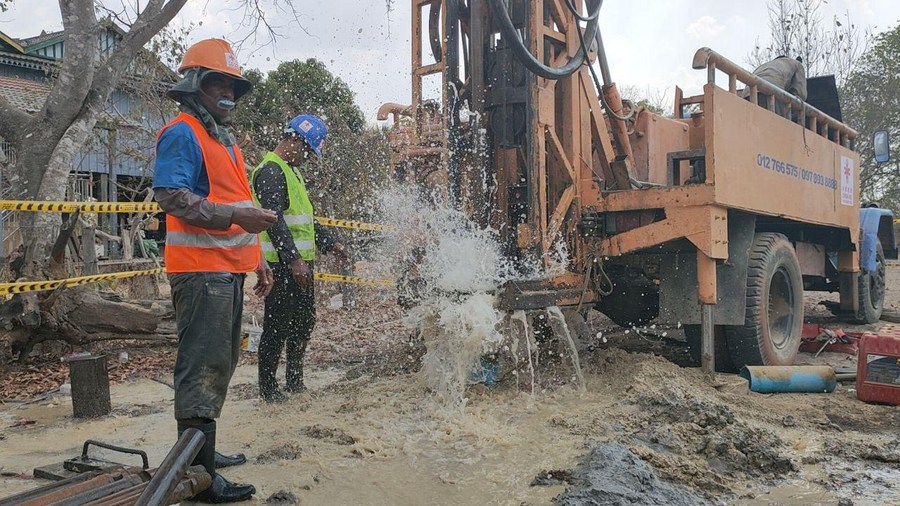
A newly-dug well jets water in Banteay Meanchey province, Cambodia. (China Jiangxi International Economic and Technical Cooperation Co., Ltd./Handout via Xinhua)
Cambodia has seven Chinese-built hydropower dams with a combined generating capacity of 1,328 megawatts and three coal-fired power plants supplying 675 megawatts. The electricity available for Cambodia was 3,382 megawatts in 2019, according to a Cambodian Mines and Energy Ministry report released in February.
Commenting on energy projects under the China-Pakistan Economic Corridor (CPEC) program, Muzaffar Ali, an expert from Pakistan's University of Engineering and Technology, Taxila, said, "China has in recent years been investing Pakistan under CPEC in the energy sector with a special focus on producing non-polluting energy by utilizing clean resources including solar, wind and hydro."
GAME CHANGERS
As part of CPEC, the Dhabeji Special Economic Zone in Pakistan's Sindh province will attract 1 billion U.S. dollars in investment and generate 100,000 jobs, Abdul Azeem Uqaili, a top economic zone official, said.
Pakistani Prime Minister Imran Khan said, "Pakistan's special strategic location connects it to the world's biggest markets, as well as the energy corridor. So we are really very well placed and CPEC is a great opportunity for us to move forward from here."
Along the Belt and Road there also stands other economic corridors, special economic zones, and industrial parks.
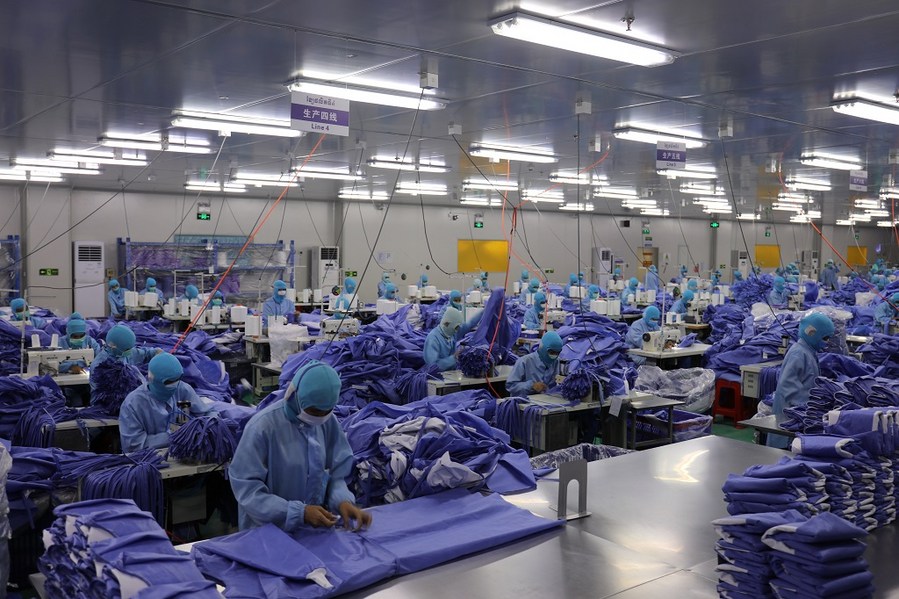
A workshop in an industrial park in Sihanoukville Special Economic Zone (SSEZ) in Preah Sihanouk province, Cambodia, June 16, 2020. (Xinhua/Photo provided by SSEZ)
Regarding the Belt and Road projects in Cambodia, Neak Chandarith, founding director of the Cambodia 21st Century Maritime Silk Road Research Center, said, "These projects will help spur the development of Cambodia by elevating Cambodia from a lower-middle income country to an upper-middle income country by 2030."
A NATION'S FUTURE
Sri Lanka's Colombo Port City and comprehensive development of the Hambantota port, both flagship Belt and Road cooperation projects, are all about the future of a nation.
The Colombo Port City project is designed to reclaim 269 hectares of land from the sea to build a central business district integrating finance, tourism, logistics and information technology for Colombo.
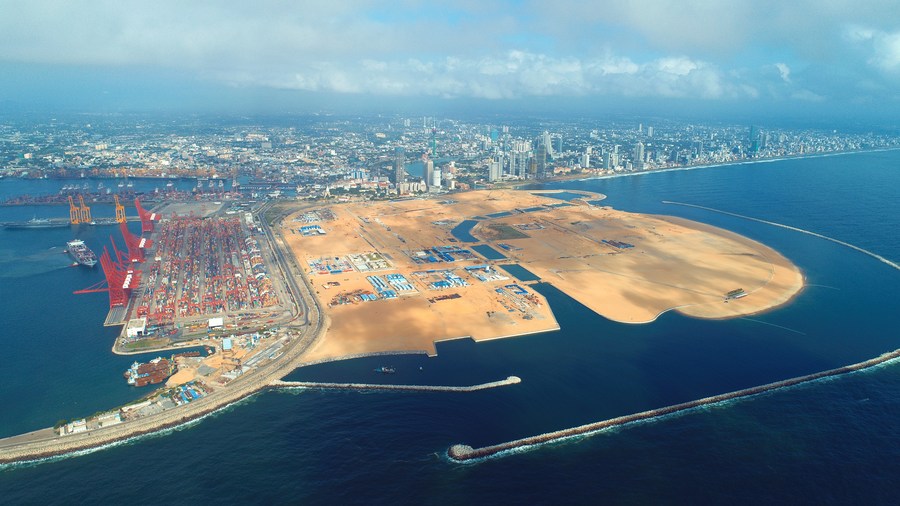
Colombo Port City being built in the Sri Lankan capital Colombo, Sept. 23, 2020. (China's CHEC Port City Colombo (Pvt) Ltd./Handout via Xinhua)
"Colombo Port City will be the main income generator for the future Sri Lanka," Sri Lankan Prime Minister Mahinda Rajapaksa said. "It is more for the future generation to be born."
President Gotabaya Rajapaksa said, "The extension of the Southern Expressway up to Hambantota will connect lives, livelihoods and boost economic activity," adding it "supports our vision of making Sri Lanka a logistic hub in Asia."
As for the Hambantota port project, he said, "Many geo-political analysts have interpreted this project as a 'debt trap' set up by China to gain control over Sri Lankan affairs. I want to prove that this is not the case and that this large-scale project will help improve the living standards of the people."
As of Nov. 17, 2020, 138 countries and 31 international organizations have signed 201 documents on BRI cooperation.
More is yet to come with the Belt and Road, which connects not only roads in countries but also the minds and hearts of people.
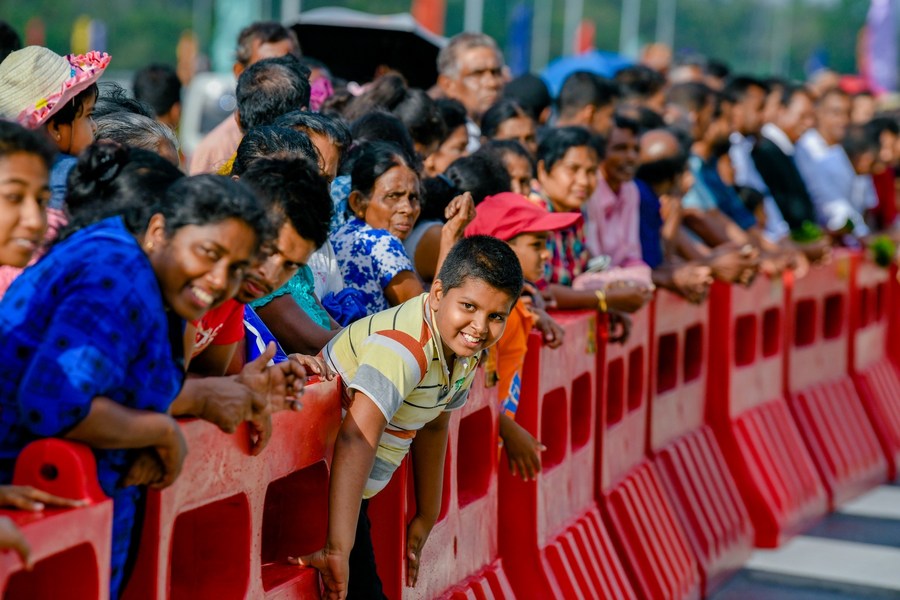
Residents in Barawakumbuka, Sri Lanka, wait for official opening of the extension of Southern Expressway, Feb. 23, 2020. (Xinhua)
(Xinhua reporters Zhang Jianhua in Vientiane, Zheng Shibo in Jakarta, Mao Pengfei, Nguon Sovan in Phnom Penh, Liu Tian, Li Hao, Jamil Bhatti in Islamabad, Liu Chuntao, Naim-Ul-Karim in Dhaka, Tang Lu, Jamila Najmuddin in Colombo contributed to the report.) ■


